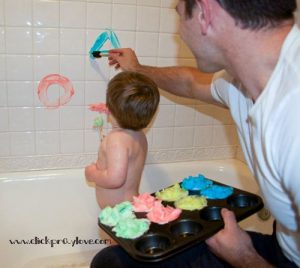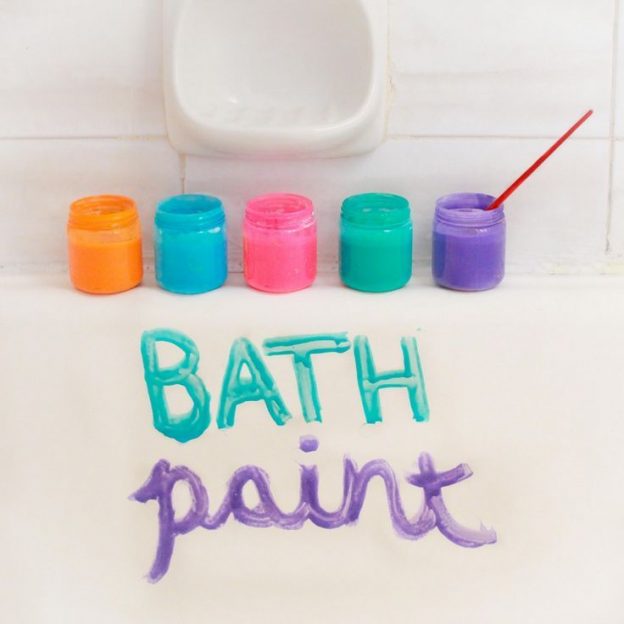Bath Tub Paint
Why did I choose this activity?
One of my favorite activities as a kid was bath time. My parents made bath time fun and engaging with toys and other activities. A daily chore suddenly became a fun activity for my brother and I. We were happy because it turned into a game and my mother was happy because bath time went smoothly each night.
To help parents with this daily chore, I have decided to focus on bath time sensory play for my assignment. Instead of dreading bath time, children will look forward to painting in the bathtub. This activity will make bath time a more positive experience and a learning experience. It is an easy activity that engages children to interact with their surroundings, as well as being just the right amount of messy. This is also a project that parents can do on a regular basis and has many options to make the activity more unique.

Sourced from: http://www.clickpraylove.com/2012/01/toddler-activity-4-make-your-own.html
How do you make Bath Tub Paint?
The Bath Tub Paint can be made one of two ways. The formulas are very similar, but the budget will dictate which option is used. The first formula is shaving cream and food coloring. The second formula is cornstarch, baby shampoo or soap and food coloring. Both are safe formulas, but, of course, they should not be ingested or come into contact with the children’s eyes. The parent can use any sort of container that they have at their house. In many of the examples found online, a cupcake pan was used so that the different colors could be separated. Cups, plates, or even empty yogurt containers could easily be used as a substitute.
Attached with the ingredients for the activity will be instructions on how to make the Bath Tub Paint. The instructions will include points like the ratio of food coloring and clean up instructions. For ease of the project, I’d like to use the formula with just the shaving cream. That way there is no measuring needed and the formula is the correct consistency. It will also cut down on preparation time and give more time for the parent and child to participate in the activity.
What can parent and child paint specifically?
In addition to the instructions, I would also like to include activity suggestions. Such as painting a specific animal, the child writing their name, or playing tic-tac-toe. By attaching these activity ideas, this activity will be less like to turn into the child drawing swirls all over the walls. But if the parent or the child’s siblings want to do that, they are welcome to! Including directions will help this activity to be more constructive and interactive for the parent.
If possible with the budget, I’d like to include the primary colors (red, blue and yellow) to make this into a color mixing activity as well. Included in the instructions would be a color wheel so the child could learn the concepts of color mixing. Plus, they’d have more than one color to create with. It could also be helpful to see how the colors change based on how many drops of each color they add. I’d also like to include two paintbrushes so that the parent or sibling can interact with the child at the same time.
How does this activity foster growth and learning in the child?
This activity will stimulate the child’s creative side and improve their fine motor skills. It also is classified as sensory play, as the texture of the paint is unique. This is especially true if the shaving cream formula is used. The visual aspect of the cream dispensing from the can would be fascinating to young children. Sensory activities are very important for a child’s development, as the development of these skills can have a positive influence on a child’s readiness for kindergarten (Cameron et al, 2012). Since Head Start is all about getting children ready for kindergarten, this is a great activity to help build those curiosities and skills early on.
This activity combines the senses of touch with vision and smell. By doing this activity with a parent or with their siblings, the child is also gaining skills with social and emotional development by creating conversation and taking turns with dipping their paintbrush in the ‘paint.’ Children three to five years of age are just starting to gain independent emotional skills, but still look to elder siblings and parents of the socially appropriate ways to react to situations (Thompson, 1991). By playing interactive games with the paint, the child is learning how to celebrate winning and cope with losing a game as well as taking turns and respecting boundaries.
Works Cited
Cameron, C. E., Brock, L. L., Murrah, W. M., Bell, L. H., Worzalla, S. L., Grissmer, D. and Morrison, F. J. (2012), Fine Motor Skills and Executive Function Both Contribute to Kindergarten Achievement. Child Development, 83: 1229-1244. doi:10.1111/j.1467-8624.2012.01768.x
Thompson, R. A. (1991, November 4). Emotional regulation and emotional development. Retrieved from https://link.springer.com/article/10.1007/BF01319934

